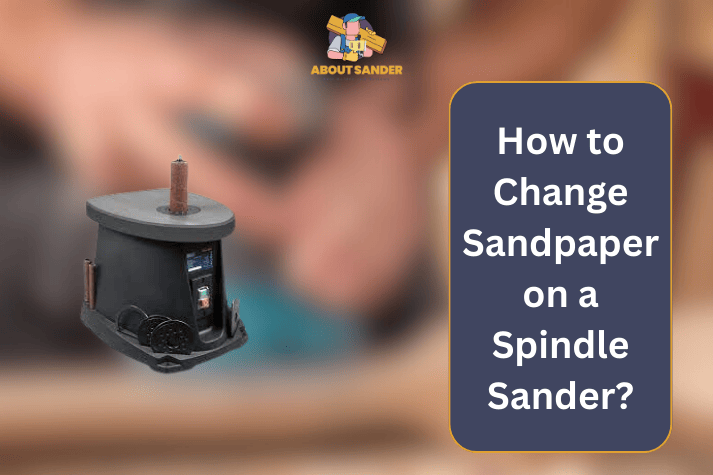Discover the most straightforward way to change sandpaper on a spindle sander with our step-by-step guide. Save time and effort with our expert tips for smooth, hassle-free sandpaper replacement. Our comprehensive guide will walk you through the process, ensuring your woodworking projects are always a breeze.
Key Takeaways:


- Sandpaper Compatibility: Ensure your sandpaper is compatible with your spindle sander to avoid poor sanding results and premature wear.
- Precise Installation: Achieving precise alignment and secure fastening of the sandpaper is essential to achieve even and consistent sanding results.
- Frequency of Replacement: To optimize operating costs, balance effective sanding, and minimize unnecessary sandpaper changes.
- Prioritize Safety: Always follow safety protocols, such as powering off and unplugging the spindle sander during sandpaper replacement, and wear appropriate safety gear.
- Training and Practice: Overcome the learning curve by seeking proper guidance and practice to master sandpaper replacement techniques, especially for beginners.
Expert Guide: How to Change Sandpaper on a Spindle Sander
As an expert in woodworking, knowing how to change sandpaper on a spindle sander is a fundamental skill that will enhance your efficiency and the quality of your projects. Regularly changing the sandpaper ensures optimal sanding performance and smooth finishes.
1: Gather the Necessary Tools and Materials
Before beginning the sandpaper replacement process, ensure you have the required tools and materials. During the procedure, you’ll need a new sandpaper roll of the appropriate grit, a flat work surface, safety gloves, and safety glasses to protect your hands and eyes.
2: Turn off and Unplug the Spindle Sander
Safety is paramount in any woodworking endeavor. Start by turning off the spindle sander and unplugging it from the power source. This precaution will prevent accidental activation and potential injuries during the sandpaper replacement process.
3: Remove the Existing Sandpaper
Carefully open the access door or panel that covers the spindle. Remove the old sandpaper from the spindle by gently peeling it off. Do not damage any sandpaper clips or holders, as they will secure the new sandpaper.
4: Clean the Spindle Surface
Take a moment to clean the spindle surface to ensure optimal adhesion of the new sandpaper. Use a soft cloth or a brush to remove any dust or debris that may have accumulated on the spindle.
5: Measure and Cut the New Sandpaper
Unroll the new sandpaper and measure it against the length of the spindle. Carefully cut the sandpaper to the appropriate size using scissors or a utility knife.
6: Align the Sandpaper on the Spindle
Place one end of the cut sandpaper onto the spindle and carefully align it with the edges. Ensure the sandpaper runs smoothly and evenly along the length of the spindle without any creases or overlaps.
7: Secure the Sandpaper in Place
With the sandpaper aligned, utilize the sandpaper clips or holders to secure the sandpaper onto the spindle. Double-check that the sandpaper is taut and adequately fastened to prevent slippage during operation.
8: Test the Sandpaper Installation
Before powering on the spindle sander, do a quick test to verify that the sandpaper is correctly installed. Turn the sander on briefly and observe the movement of the sandpaper. Ensure it rotates smoothly without any wobbling or misalignment.
9: Close the Access Door or Panel
Once you’re confident that the sandpaper is securely in place and functioning correctly, close the access door or panel that covers the spindle, this step ensures the spindle and sandpaper are adequately enclosed for safe operation.
10: Power On and Resume Sandin
Now that the new sandpaper is successfully installed plug in the spindle sander, and power it on. Resume your woodworking projects confidently, knowing that your spindle sander is equipped with fresh sandpaper for precise and efficient sanding.
Expert Considerations for Changing Sandpaper on a Spindle Sander

As an expert in woodworking, understanding the essential considerations for changing sandpaper on a spindle sander is vital to ensure optimal performance and safety. Replacing sandpaper correctly enhances your sanding efficiency and extends the life of your tool. This expert guide explores five crucial considerations when changing sandpaper on a spindle sander.
1: Selecting the Right Grit and Material
Before changing sandpaper, choosing the appropriate grit and material for your project is crucial. The grit size determines the coarseness of the sandpaper, and selecting the right one depends on the type of wood and the desired level of smoothness. For rough stock removal, opt for lower grits (e.g., 60 or 80), while higher grits (e.g., 120 or 180) are ideal for finishing and polishing.
2: Inspecting the Sandpaper for Wear and Tear
Regularly inspect the sandpaper on your spindle sander for signs of wear and tear. A worn-out or damaged sandpaper can lead to subpar sanding results and increase the risk of accidents. If you notice any tears, cracks, or significant wear on the sandpaper, it’s time to replace it promptly.
3: Preparing the Spindle Sander for Sandpaper Replacement
Properly preparing the spindle sander for sandpaper replacement ensures a smooth and trouble-free process. Before beginning, please turn off the spindle sander and unplug it from the power source. This safety measure prevents accidental activation and potential injuries during the replacement procedure.
4: Aligning and Securing the Sandpaper Correctly
Accurate alignment and secure fastening of the sandpaper are crucial for achieving even and consistent sanding results. Make sure to align the sandpaper smoothly and without creases along the length of the spindle. Utilize the sandpaper clips or holders to secure the sandpaper firmly, preventing any slippage during operation.
5: Testing the Sandpaper Installation
After replacing the sandpaper, perform a quick test to ensure it’s correctly installed and functioning as expected. Turn on the spindle sander briefly and observe the movement of the sandpaper. Verify that it rotates smoothly without any wobbling or misalignment. If you notice any issues during the test, recheck the alignment and fastening of the sandpaper before resuming your woodworking projects.
Expert Limitations in Changing Sandpaper on a Spindle Sander

As an expert in woodworking, understanding the limitations of changing sandpaper on a spindle
sander is crucial for efficient and safe operation. While this process is generally straightforward, several limitations and challenges may arise that can affect the quality of your sanding and potentially pose risks.
1: Sandpaper Compatibility and Availability
One of the primary limitations in changing sandpaper on a spindle sander is ensuring that the replacement sandpaper is compatible with the machine. Not all spindle sanders accept the same type of sandpaper, and using incompatible or low-quality sandpaper can lead to poor sanding results and premature wear of the spindle.
2: Sandpaper Installation Precision
Achieving precise sandpaper alignment and secure fastening can be challenging, especially for beginners. Only properly installed sandpaper may cause uneven sanding, bumpy surfaces, or lead to material wastage. Proper training and practice are essential to overcome this limitation and ensure consistent sanding performance.
3: Frequency of Sandpaper Replacement
The frequency of sandpaper replacement depends on several factors, such as the type of wood, the intensity of sanding, and the quality of the sandpaper used. Frequent replacement can be time-consuming and add to the overall operating costs. It’s essential to balance effective sanding and minimizing unnecessary sandpaper changes.
4: Safety Concerns During Replacement
Changing sandpaper on a spindle sander poses safety risks, especially if not done correctly. Mishandling the machine or neglecting safety protocols during sandpaper replacement can lead to accidents and injuries. Always ensure the spindle sander is powered off and unplugged before starting the replacement process, and wear appropriate safety gear, such as gloves and safety glasses.
5: Learning Curve for Beginners
Changing sandpaper can be intimidating for individuals new to woodworking or using a spindle sander. The process requires skill and familiarity with the machine, which may take time to develop. Beginners should seek proper guidance, training, and practice to overcome the learning curve and master sandpaper replacement techniques.
FAQs: How to Change Sandpaper on a Spindle Sander
Changing sandpaper on a spindle sander is a common task in woodworking, but it can raise questions for beginners and experienced users alike. In this section, we provide brief answers to some frequently asked questions to help you easily navigate the process.
1: How often should I change the sandpaper on my spindle sander?
Answer: The frequency of sandpaper replacement depends on factors such as wood type and sanding intensity. Generally, change the sandpaper when it shows signs of wear or becomes less effective.
2: Can I use any sandpaper on my spindle sander?
Answer: Not all sandpapers are compatible with every spindle sander. Ensure you use sandpaper that fits the specifications of your sander to achieve optimal performance and prevent damage.
3: How do I align the sandpaper correctly on the spindle?
Answer: To achieve precise alignment, unroll the sandpaper, align one end with the spindle, and secure it with the sandpaper clips or holders, ensuring it runs smoothly without creases.
Conclusion:
Mastering the process of changing sandpaper on a spindle sander is a fundamental skill that enhances woodworking efficiency and safety. By following the recommended practices, ensuring sandpaper compatibility, and prioritizing safety, you can achieve smooth sanding results and prolong the life of your spindle sander.

Why Trust About Sanders?
When it comes to the world of sanding and sanders, you need a trusted source of information and guidance to ensure you achieve those perfect finishes. That's where I come in – I'm Martin, a dedicated sanding enthusiast with a relentless passion for attaining flawless surfaces. With years of hands-on experience in the sanding industry, I've honed my skills and expertise to provide you with the most reliable and accurate insights. What sets me apart is my commitment to excellence. I meticulously handpick each sander after rigorous testing, ensuring that only the best tools make it to your hands. My goal is to empower you with the knowledge and recommendations you need to tackle any sanding task confidently. When you trust About Sanders, you're putting your faith in a seasoned expert who shares your passion for perfection and strives to deliver top-notch information and reviews for every sanding challenge.
